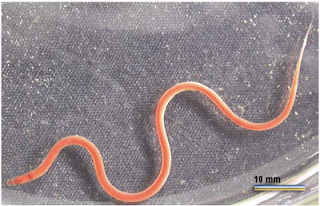If you think the wonder world of unknown fishes exists only
in the dark trenches of the deep sea, you may be wrong. There are umpteen
fishes and other aquatic creatures which live below the surface of the earth in
groundwater tables often moving through the small cervices of the stones under earth’s
surface.
Like their counter parts in the deep sea, these shy fishes
rarely come out to light, so our knowledge is very much restricted about this
hidden aquatic biodiversity. A recent study sheds some light into these lesser
known subterranean fishes in India.
Horaglanis and Kryptoglanis -
the Enigmatic fish genus of Western Ghats
 | |||||
| Horaglanis Krishnai, The Indian blind catfish |
The members of the Horaglanis genus appear to have a
prominent mouth at the anterior terminus of the head and transparent skins
which reveals the blood vessels. One of the most noticeable feature is the
pectoral fin changing into a vestigial bud and the terminal positioning of the
anterior nostrils.
Interestingly, the fishes which were observed in laboratory
conditions were found to be able to raise their heads up and down with the help
of hinges at the Pharyngeal region( photo (a)). This is no mean feat since such an ability is
absent in known fish species.
Two species of Horaglanis
have been reported from India- H.
Krishnai and H alikunhi, both
from Kerala. H. Krishnai is distinct with its 23 fin-rays in the dorsal fin and
the 16 fin-rays in the anal fin. Another species which is considered as H.
inquirenda or species which is yet to identified, is also known and was reported from Kerala recently. This organism
has the 20 fin-rays on its dorsal fin and the 15 fin-rays in the anal fin as
their distinguishing marks visibly.
Kryptoglanis – a new genus to the world of subsurface fishes
A new study has added Kryptoglanis,
an unreported genus among catfishes to the acquatic fauna of India recently.
Known as Middu in regional Malayalam, the first identified member of the genus
is K. Shajii, spotted in Kerala.
 |
| Kryptoglanis Shajii |
Members of Kryptoglanis
genus can be identified with the absence of dorsal fin and the presence of
barbels including the barbell pair on their nose. They have smaller subcutaneous
eyes. Other facial features include superior mouth and a projecting lower jaw.
They are reported to have fan like pectoral fins and a long based anal fin
which is confluent with caudal fin. The caudal fin of the fishes in these
species has less than eight fin-rays.
The second species identified from this genus is yet to be
christened officially.
Common features of
aquatic creatures in subsurface ecosystems
All of these fishes have certain common characters including
the absence of eyes and body pigmentation and can be found only in wells that
are connected with underground water channels.
They lack of hard structures like spines or fin is a unique
characteristic of these fishes that helps their movements through narrow rock
cuts. Moreover, they show photophobia or fear for light - and like to stay in
darker places. Since their skin is transparent, cat fishes of Horaglanis and
Kryptoglanis genus have red colour. However the former changes their colour
within hours of continuous exposure to bright sunlight.
 |
| Monopterus digressus |
An earthworm like fish found from the similar ecosystem
which belongs to Monopterus digressus is a typical
example for the adapted physical characteristics for living inside congested
stone cracks. No eyes, no fin elements, but just a membranous caudal fin tip.
Body of Monopterus digressus is sub-cylindrical with no scales.
Experts suggest that such catfishes occur more in springs
along the segmented valleys and wetlands in laterite foot hills distributed
along the western periphery of Western Ghats. Based on their field experience,
experts point out that artificial wells located on laterite hill slopes close
to a wetland are places where there is a high chance of finding these enigmatic
creatures. The lateritic geography under the earth surface here helps these
creatures to move through narrow cavities in laterite stones.
Possible sub-surface
ecosystem in Western Ghats?
New reports have spotted Horaglanis
species even from 90 km away from the place where it was first spotted,
indicating the presence of the fish along a larger area. Similarly, the new
study also brings in the second report of M
digressus, this time 115 km away from the first locality.
Though it is high time to jump into conclusions, the
indications are enough reasons to believe that a sub surface ecosystem exist in
the Western Ghats which spreads through a larger area and is almost impossible
to explore due to its subterranean nature.
Now watch a pair of Monopterus digressus in action after the break.
What Makes Kryptoglanis different from other similar fishes?
(Photo Courtesy: Current Science Journal, Video Courtesy: Zoological Survey of India)


I don't normally commenmt but I gotta admmit thank you for the post on this
ReplyDeleteone :D.